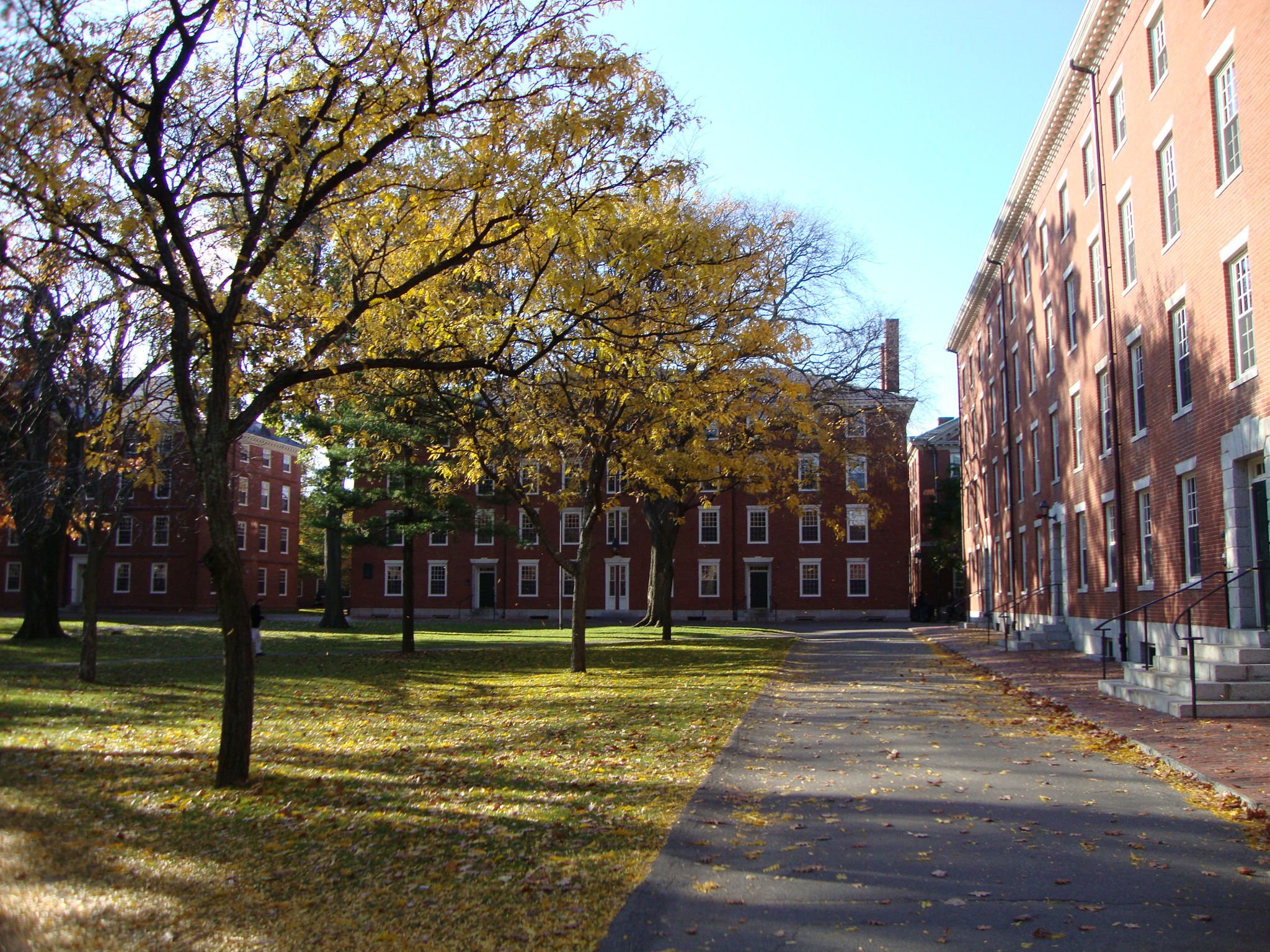Boston is the capital and largest city of Massachusetts. It’s one of the most amazing cities in the world with a lot of great architecture and interesting history on the American Revolution and how the United States was born. Technically Massachusetts is a Commonwealth and not a State, but then again it is considered one of the 50 states. There are four Commonwealths in the United States in total. The other three are Kentucky, Pennsylvania and Virginia. All four states were among the 13 first of the Union. Being a Commonwealth has no legal significance other than it emphasises that they have a government which is based on the common consent of the people as opposed to one legitimised through their early royal colony status which came from the monarch of Great Britain.
The term is also used for the US Commonwealths of Puerto Rico and the Northern Mariana Islands but have no legal meaning. These are US territories and not US states.
A great way to get around Boston is by foot, but if you have to travel greater distances, the Boston Subway (MBTA – Massachusetts Bay Transit Authority) is a recommended option. There are train stations within walking distances all over the city centre.
Boston has had a pivotal role in American history. Some of the most defining moments in the country’s history happened here such as the Boston Massacre, the Boston Tea Party which led to the American Revolution.
The Boston Massacre took place in 1770. British troops had been stationed in town since 1768 to protect colonial officials who were trying to enforce unpopular parliamentary legislation. Because of these there was a tense atmosphere in town and on the 5th of March 1770 a mob surrounded a guard and verbally abused and harassed him. He was supported by eight soldiers who were subject to verbal threats and thrown objects and they ended up opening fire against the crowd without orders. Three people were killed instantly, several were wounded and two died later from their injuries. Leading patriots Samuel Adams and Paul Revere would heavily propagate the event to create hostility against the British Authorities. The discontented crowd would scatter in the end as acting Governor Thomas Hutchinson promised an inquiry which resulted in the arrest of eight soldiers, one officer and four civilians who were charged with murder. Defended by lawyer and future American president John Adams, six of the soldiers were found not guilty and two were convicted of manslaughter but were given reduced sentences.
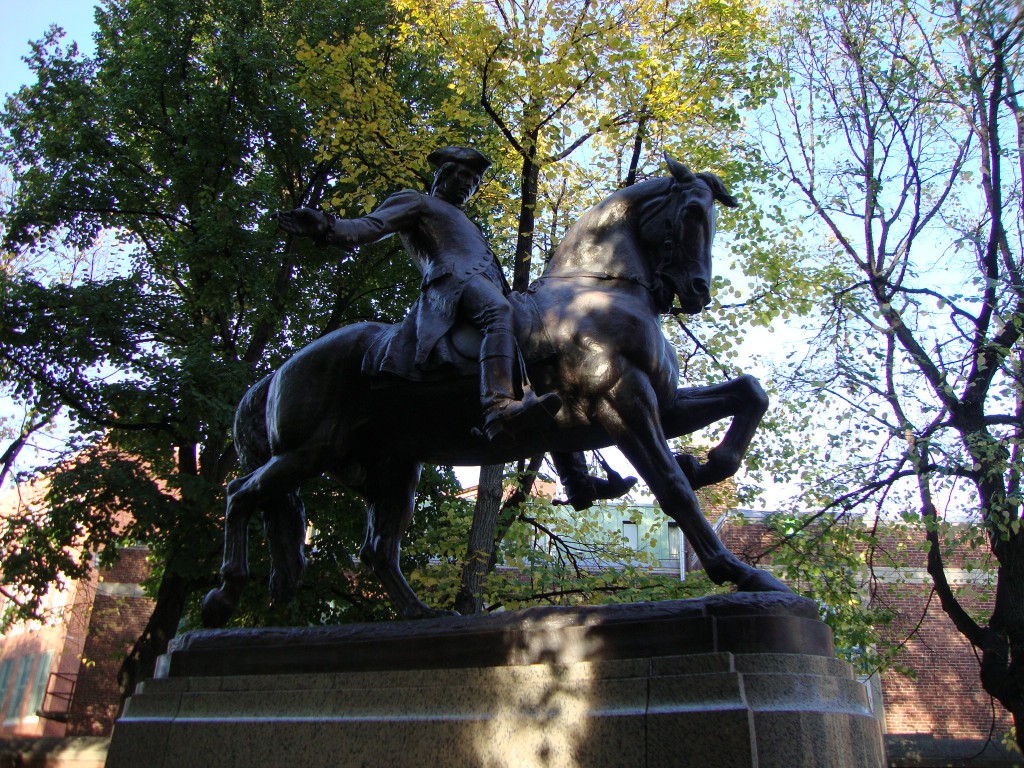
The Boston Tea Party was a political protest which happened on the 16th of December 1773 and was a crucial event in the American Revolution. It was organised by The Sons of Liberty who destroyed a whole tea shipment from the East India Company by dumping it overboard as a protest against the Tea Act of 1773. The Sons of Liberty was an organisation of landowners based in all the original thirteen colonies who would protect the rights of the colonists and fight against taxation from the British Government. They didn’t want to be taxed by somebody who didn’t represent them and which was exactly what the British Government didn’t do. They had to raise taxes to fund their wars against the French in Canada. The British introduced the Coercive Acts to punish the colonists of Massachusetts because of the Boston Tea Party. The patriots called these the Intolerable Acts. These took away the self-government of Massachusetts and historic rights which created outrage in the thirteen colonies and sparked the American Revolution in 1775 which began outside Boston.
The American Revolutionary War took place from 1775 to 1783 and led to the Declaration of Independence by the United States in 1776. After the British Government punished Massachusetts by closing the harbour of Boston, patriots in Massachusetts created a shadow government which was supported by the other 12 colonies. It took control of the province outside of Boston. A Continental Congress was formed by the thirteen colonies to coordinate the resistance which in the end seized power from the British. In April 1775 war broke out between Massachusetts and the British. General George Washington was appointed by the Continental Congress to be in charge of the militia against the British forces in Boston who were forced out in March 1776. The rebellion which led to the independence in 1776 ended in an alliance with France in 1778 which escalated into a war between Britain and France, Spain and the Netherlands worldwide. The participation of these three countries was essential for the new nation as they had lost some major battles to the British in New York and New Jersey. It forced the British to divert a big portion of the resources away from North America. After 1778 the British shifted their attention to the southern colonies by recapturing Georgia and South Carolina in 1779 and 1780 but they failed to win Virginia which led to the naval victory by France outside Chesapeake Bay and the Franco-American siege at Yorktown and the capture of more than 7,000 British soldiers. This defeat and several of other reversals resulted in the British Parliament turning against the war. In 1783 the Treaty of Paris recognised the United States as a sovereign country stretching roughly from present day Canada in the north to Florida in the south and the Mississippi River in the West.
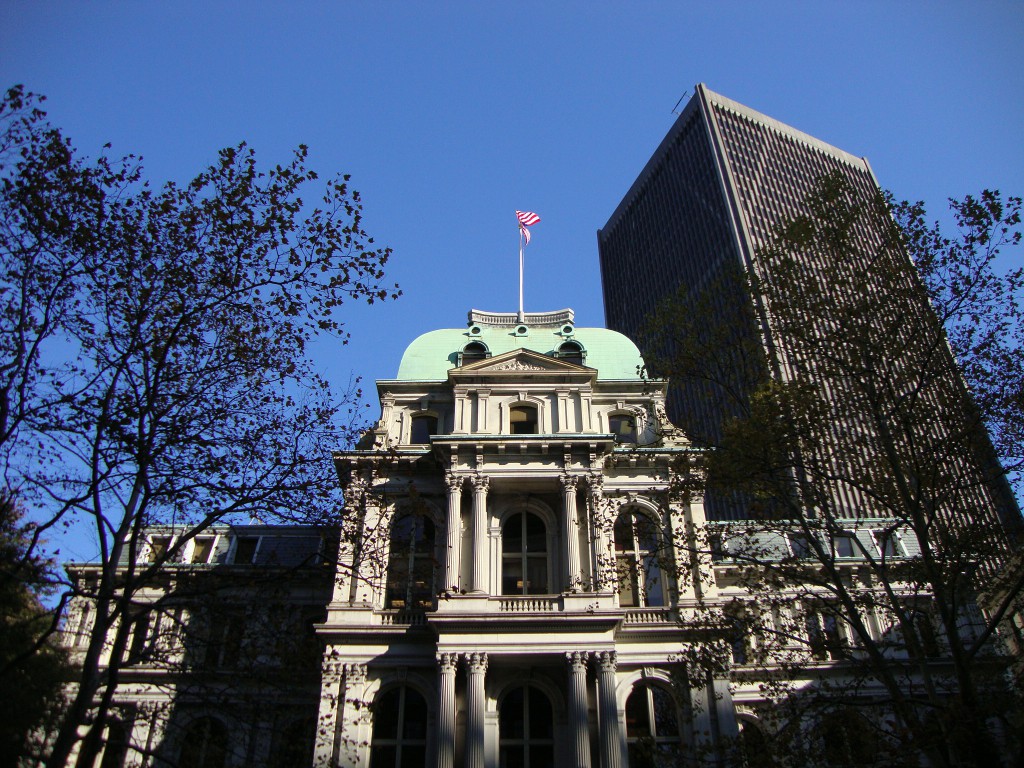
Doing “The Freedom Trail” is an absolute must when you are in town. It’s a 4 km (2.5 miles) long path which will take you through all the major historic sites in Boston related to the early history of the country. The trail is marked with a red line in the ground and takes you to 16 locations along the way. This will include historic buildings, meetinghouses, churches and burial grounds. The highlights are the Massachusetts State House, the Old South Meeting House, the Old State House, Faneuil Hall and the Paul Revere House. If you are staying at a hotel they will most likely have maps and information on the trail. You could also start at the Boston Common where there’s a Visitor Center at 139 Fremont Street.
The Old City Hall located at 45 School Street is a beautiful building in the architectural style of French Second Empire and served as the city hall from 1865 to 1969. It was the first one to be built in this style in the United States and one of the few still standing. In Paris this style gained popularity in the day when the Louvre was completed. The characteristic is the mansard roof which is a four-sided gambrel-style hip roof by having two slopes on each of its sides, a shallow slope above a steeper slope. The steep slope may be curved. Often the building will have a projection centre which is topped by a dome, tall windows and doors which are flanked by a pair of columns. A statue of Benjamin Franklin is based in front of the Old City Hall which is pretty neat.
Visiting the Old State House is an absolute must. It is officially called the Old State House Museum and Boston Massacre Site. It was here that John Adams, John Hancock, Samuel Adams and other patriots debated the future of American self-government and set the American Revolution in motion. It’s located in the heart of the city at the intersection of Washington and State Streets, was built in 1713 and is a great example of Georgian architecture. Before the American Revolution this was where the colonial government was based for the people of Massachusetts where it incorporated British power and authority. But from 1760 to 1776 it was transformed into to symbol of resistance and independence as it became a focus of will for self-government. Upstairs in the building, in 1768 the Massachusetts assembly defied the British and sent a letter drafted by Samuel Adams to the other colonies asking for unity against unfair taxes. Also upstairs in 1780, John Hancock was inaugurated as the first governor of the Commonwealth of Massachusetts who was elected by the people unlike his predecessors who were colonial governors. On the balcony the Declaration of Independence was read to the people of Boston for the first time on 18 July 1776. Some people got so excited that they tore the lion and the unicorn off the building, as they were British symbols, and burnt them. The aforementioned Boston Massacre took place just outside this building.

The Paul Revere House is one of the biggest tourist attractions in town which is located at 19 North Square in the North End. It was built around 1680 and is the oldest house in Boston. Revere was employed by the Boston Committee of Correspondence and the Massachusetts Committee of Safety as an express rider to carry news, messages and copies of resolutions all the way to Philadelphia and New York.
Paul Revere’s Midnight Ride is a story going back to the 18th of April 1775. There are several legends and myths on what went on but the following should be the real story. Revere was instructed by Dr Joseph Warren to ride to Lexington to warn Samuel Adams and John Hancock that British troops were coming to arrest them. The week prior Revere had placed two lanterns at the top of the Christ Church in Boston which was a signal indicating that the British would arrive by sea across the Charles River to Cambridge as opposed to by land. While he was in Charlestown it was confirmed by the local “Sons of Liberty” that they had seen the signal. On the way to Lexington, Revere raised the alarm at each house on his way and when arriving in Lexington around midnight he approached the house where Adams and Hancock were staying. After the message was delivered Revere was joined by a second rider by the name of Williams Dawes who had been sent on the same errand by a different route. They themselves decided to continue onwards to Concord where weapons and supplies were hidden. They were joined by a third rider called Dr Samuel Prescott. Shortly after they were all arrested by British troops. Prescott escaped immediately and Dawes soon after. Revere was held for a while and then released without a horse. He would return to Lexington by foot and witness the battle on the Lexington Green. Historians are questioning whether Revere would have raise the alarm at all the houses on his way or only selected ones with rebels he would have trusted. They also claim he would have been more low key on his route than people tend to believe as he had to be aware of red coats and loyal colonists. Furthermore it is said that Revere, Dawes and Prescott were arrested before even getting to Concord.

The Pierce-Hichborn House at 19 North Square is adjacent to the Paul Revere House and is a great piece of Georgian architecture which is one of the earliest remaining brick buildings in Boston dating back to around 1711. Its symmetrical style is a drastic change from the wooden style tudor dwellings of the Paul Revere House. The house was built for a glazier called Moses Pierce and was later owned by Revere’s cousin Nathaniel Hichborn who was a boatbuilder.
The Paul Revere Monument is based on the Paul Revere Mall (also known as the Prado) which is on the Freedom Trail. It’s a really neat brick-paved park with trees on both sides of the statue and down the mall. It is one of the most photographed monuments and most recognised lardmarks in Boston which is probably because it’s a sculpture of Revere on the legendary Midnight Ride. The creation of the statue was pretty troublesome. It took 16 years to create and 40 year to install in its present place. The artist was Cyrus Edwin Dallin, he was only 22 when was given the task and what we see today is either the 5th or 8th version, which is not exactly certain. It was opened to the public in 1940. The mall itself was established in 1933.
The Old North Church (Christ Church) is based at 193 Salem Street in the North End, just opposite the Paul Revere Mall. This is the church on which Revere placed the two lanterns on the steeple to warn of the march of the British troops to Lexington and Concord. It’s the famous “One if by land, and two if by sea” with regard to the number of lanterns. The architectural style of the church is Georgian and was built in 1723.
The North End is also known as “Little Italy” and is famous for its great Italian food. Furthermore there is a lot of great architecture in the area such as the aforementioned Paul Revere House, the Pierce-Hichborn House and the Old North Church which also makes it rich with history being the oldest neighbourhood in Boston dating back to the early 1600s where English Puritans settled in. A large part of the Freedom Trail runs though the North End as well. Hanover Street is the main street, is one of the oldest in town and was originally an Indian path with access to the shoreline. Here you will you find restaurants and boutiques among the great architecture. Also check out the side streets and Salem Street which runs parallel to Hanover Street. Very neat.
Checking out Faneuil Hall is an absolute must while you are in town which is another piece of beautiful Georgian architecture. It’s a part of the Freedom Trail and is located at 1 Faneuil Hall Square. In 1740 the wealthy merchant Peter Faneuil offered to have a marketplace built at his cost as a gift to the city. It opened in 1742 but unfortunately Faneuil died only 6 months later. Therefore the building was named after him. It was a condition by Faneuil that on the ground floor (first floor in the United States) it would be a market and on the second floor (first floor in United States) a meeting hall would be located. Boston was filled with general merchants such as Faneuil at the time and was a place where traders from all over the Atlantic world would gather. Ships would go everywhere within the British Empire. So at the time you would be able to find goods from all over the world. In 1826 it was expanded to include Quincy Market to better accommodate shoppers and merchants.
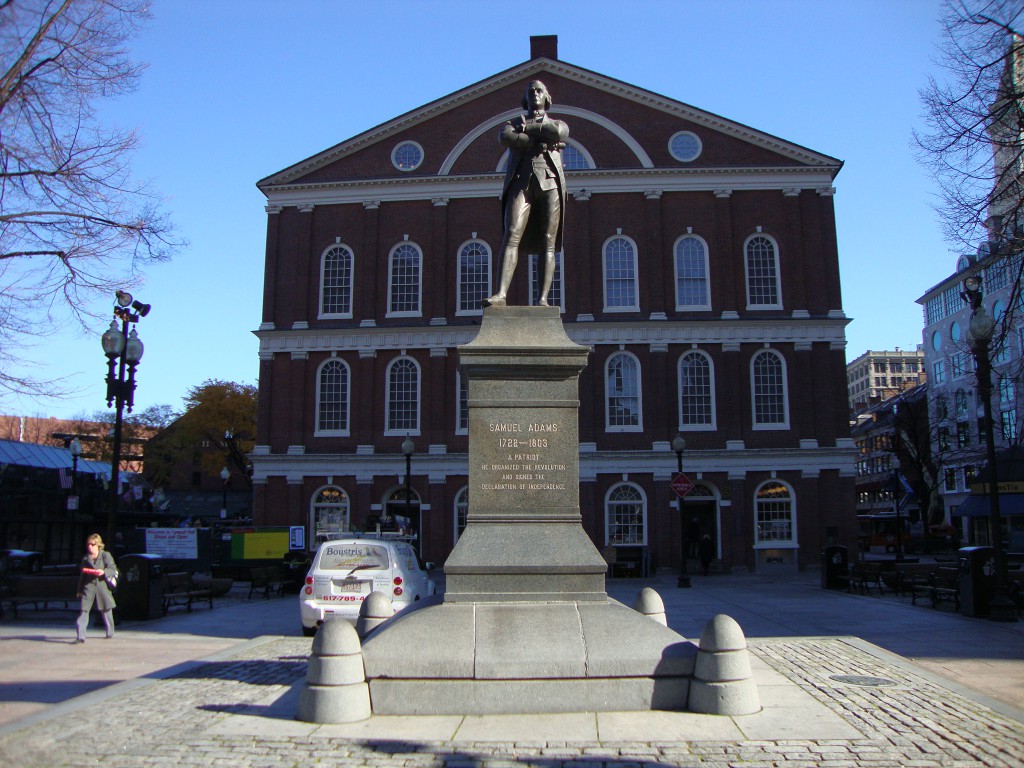
It’s been referred to as the cradle of liberty as it was an open space for people to gather. Meetings were held here for many years where people like Samuel Adams, John Hancock and Dr Joseph Warren would talk a lot about liberty and about independence from the British. The doctrine of “no taxation without representation” was established here were colonists protested against the Sugar Act in 1764 for the first time. Outside the hall on the square there is a cool statue of Samuel Adams. People affiliated with the Sons of Liberty would hang out a lot at the nearby taverns such as at the Golden Ball and Green Dragon Tavern to talk about what was going on in the day which would lead to revolutionary action. An early revolutionary leader called James Otis, Jr. picked a fight with a customs official at one of the taverns in the area, where a lot of British soldiers would hang out, and he was nearly killed by the impact of a cane on his head. There would be several political arguments in these taverns. Otis would get involved in the movement in 1761. Another important figure and one of the strongest voices of protest before the American Revolultion was Ebenezer Mackintosh who was one of the co-founders of the Sons of Liberty. They wouldn’t get in as much trouble as Samuel Adams and John Hancock who would be the only two at the time of the revolution whom the British government would not give amnesty.
On the top floor one of Boston’s best secrets is located which is the head office of the Ancient Honorable Artillery of Massachusetts. This is the third oldest chartered military organisation in the world and its history goes all the way back to 1638.
Faneuil Hall is home to about 90 shops and restaurants and is the first and longest operating shopping centre in the United States. Here you will also find a replica bar of the Cheers that appeared on the set of the tv-sitcom “Cheers” at Quincy Marketplace. They also have a souvenir shop.
The Old South Meeting Hall, built in 1729, is yet another beautiful historic structure in the style of Georgian architecture which is located at 310 Washington Street. Colonists would gather here to challenge the British government again and again, which in the end led to the American Revolution. The building was used by 5,000 colonists on 13 December 1773 where they would debate British taxation which emerged into what would be known as the Boston Tea Party. It was the cradle of the rebellion as people from all walks of life in vast numbers would participate in debate and dialogue which would change the direction of the nation. At the time it was the biggest structure in Boston.
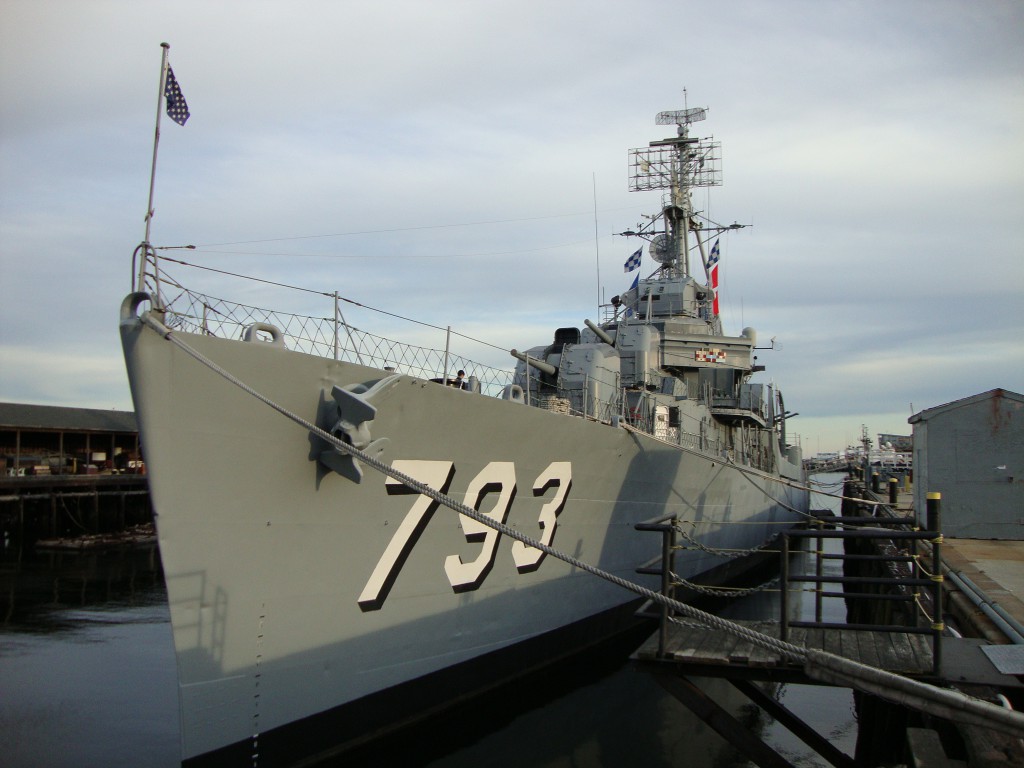
Visiting Charleston Navy Yard, Boston National Historical Park which is located at 1st Ave in Charleston is highly recommended. You can walk across the Leonard P. Zakim Bunker Hill Bridge from the North End, if you are staying in the city centre, to get there. When you get across the bridge and over to the Charleston area you will have a great view of the downtown skyline. The USS Cassin Young is a National Historic Landmark. Checking out the USS Cassin Young, which is a Fletcher-class destroyer, is a great option. It was built in San Pedro, California, was commissioned in 1943 and was named after Captain Cassin Young who earned the Medal of Honor at Pearl Harbor. It logged more than 241,000 km (150,000 miles) in the Pacific during World War II. It sustained two hits by kamikaze pilots at Okinawa, Japan which resulted in 127 dead and wounded. Even though the destroyers of this type had tremendous firepower with their 40mm anti-aircraft guns, 88 Japanese kamikaze pilots hit American destroyers. The USS Cassin Young also served at the Korean War during the 1950’s. You can walk on board and have a look around the ship. It’s very interesting and there will be posts at different locations explaining the history of the ship.
John W. McCormack Post Office and Courthouse is a beautiful Art Deco building located at 5 Post Office Square. It’s got three towers, one is setback in the middle and each side there are two twin towers. The structure has got 22 stories and is 101 metres (331 ft) tall. It’s definitely worth checking out.
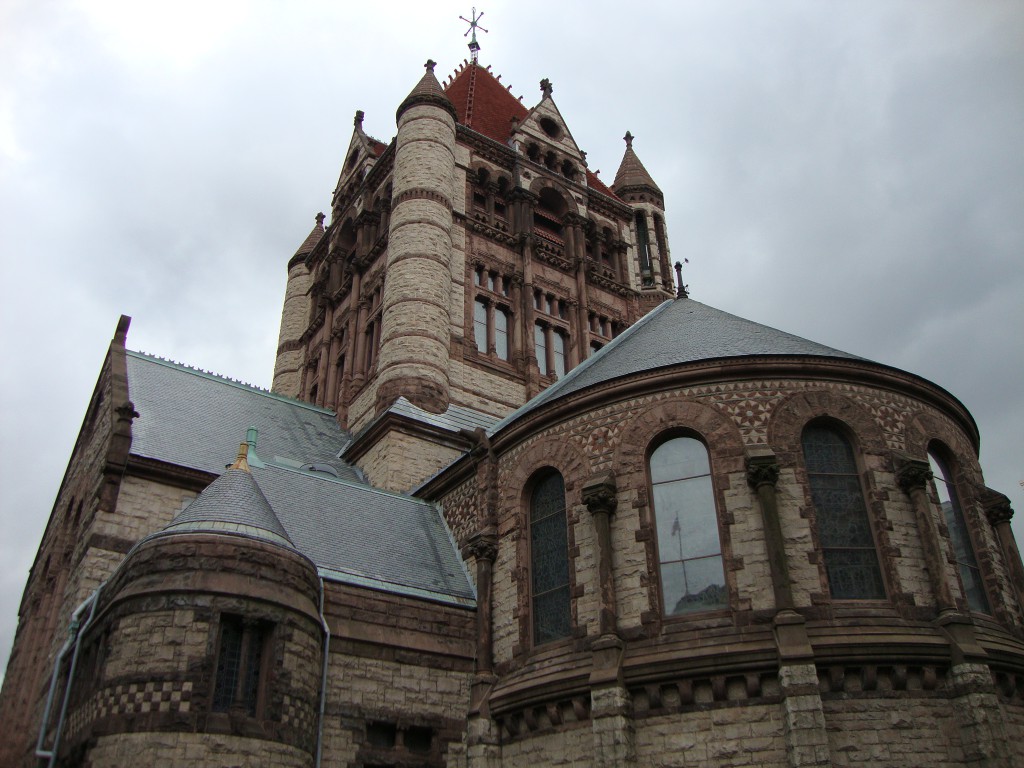
There are several historic buildings and interesting churches in the Back Bay neighbourhood such as the Church of the Covenant located at 67 Newbury Street. It was built in 1867 and the architectural style is Gothic Revival. The look is pretty distinct due to the material used which is Roxbury puddingstone, found in the bedrock of Roxbury which is a part of the city of Boston. Also worth checking out is the Trinity Church at 206 Clarendon Street in Copley Square among all the skyscrapers which was built between 1872-1877. The architectural style is Richardsonian Romanesque which is a branch of Romanesque Revival. It’s the birthplace of this style, named after Henry Hobson Richardson whose masterpiece was this very church. Back Bay used to be a mud flat, therefore the church is built on around 4,500 wooden piles, all driven through 9 metres (30 feet) of gravel fill, silt and clay. They are constantly wetted by the water table so they do not rot if exposed to air. It’s the only church and building in Boston which is on the list of the “Ten Most Significant Buildings in the United States” by the American Institute of Architects.
Another impressive church is the First Church of Christ, Scientist located at 210 Massachusetts Ave. The architectural style is Romanesque Revival and it consists of the domed Mother Church Extension from 1904-1906. The original church is from 1894.
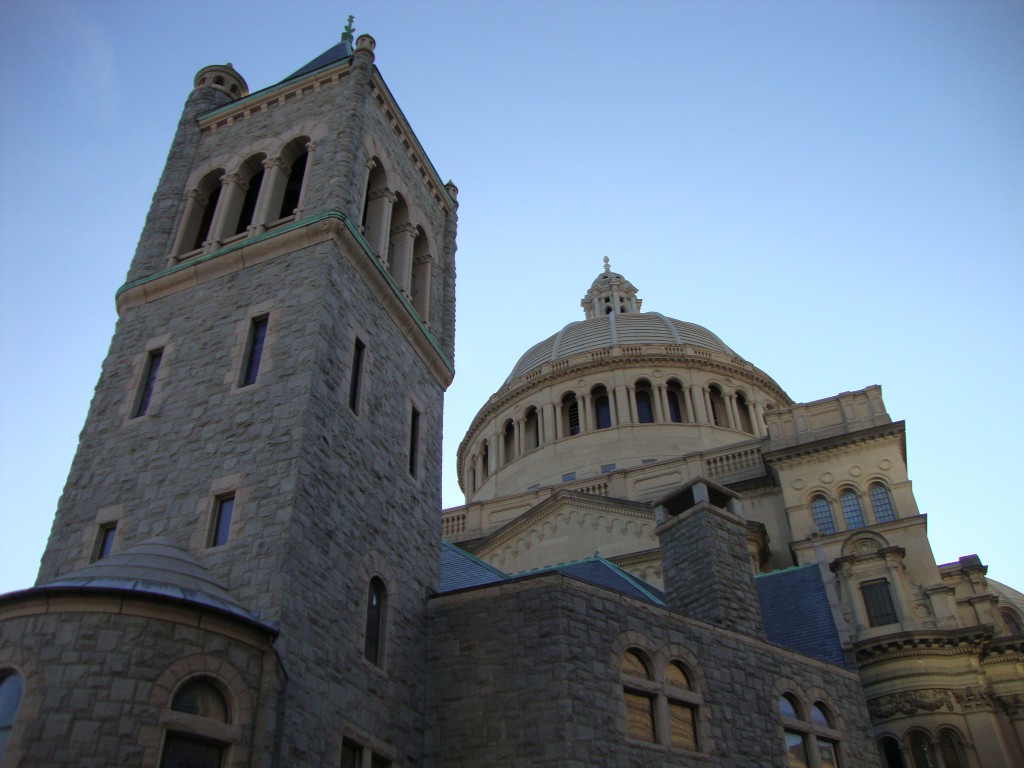
There are also several interesting skyscrapers in the Back Bay neighbourhood such as the tallest building in Boston, the John Hancock Tower which is 240 metre (790 ft) tall, has 60 stories and is located at 200 Clarendon Street. At 500 Boylston Street you will find a Post-Modern building named after the address which is pretty cool. It is 100 metres (328 ft) tall, has a floor count of 25 and is based right next to the Trinity Church.
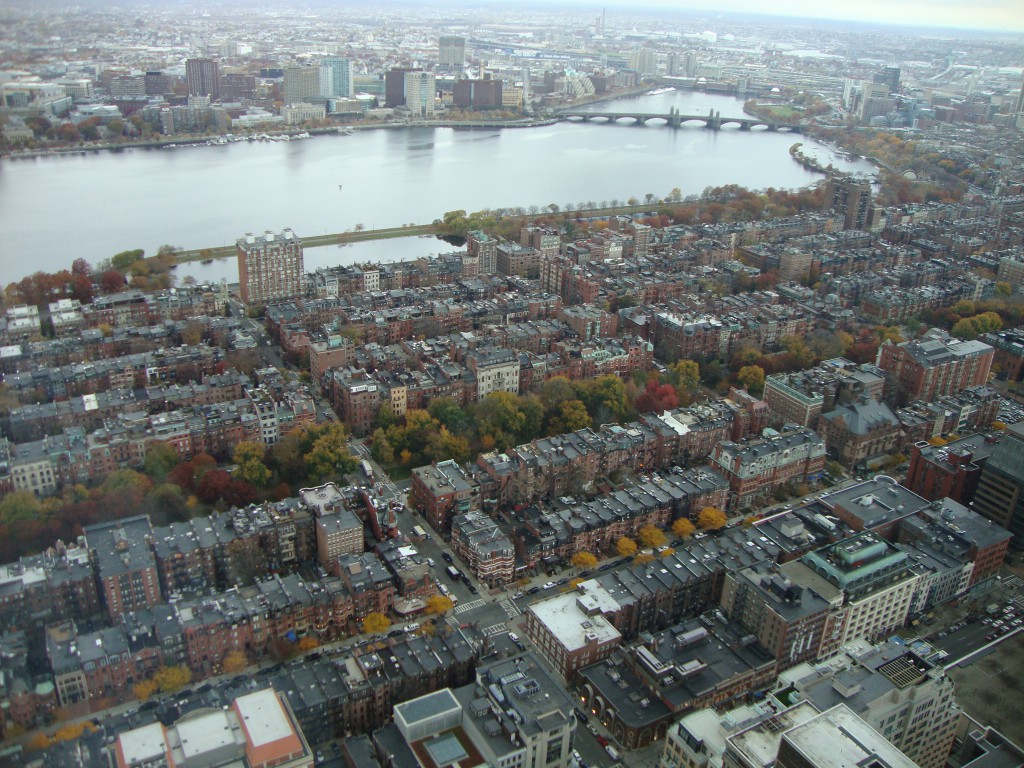
The Prudential Tower is the 2nd tallest building in Boston at 228 metres (749 ft) with a floor count of 52. The architectural style is International and located at 800 Boylston Street. On the 50th floor you will find an observation deck called the Skywalk Observatory. You will have a great view of the John Hancock Tower, Boston and the surrounding area from here. The deck is based inside the building so you will be looking through windows and therefore you will have this obstruction when taking pictures.
In Downtown at 88 Fremont Street a really cool Baptist church called the Tremont Temple is located. The façade is really beautiful due to the brickwork. It was designed by Clarence Blackall and opened in 1896.
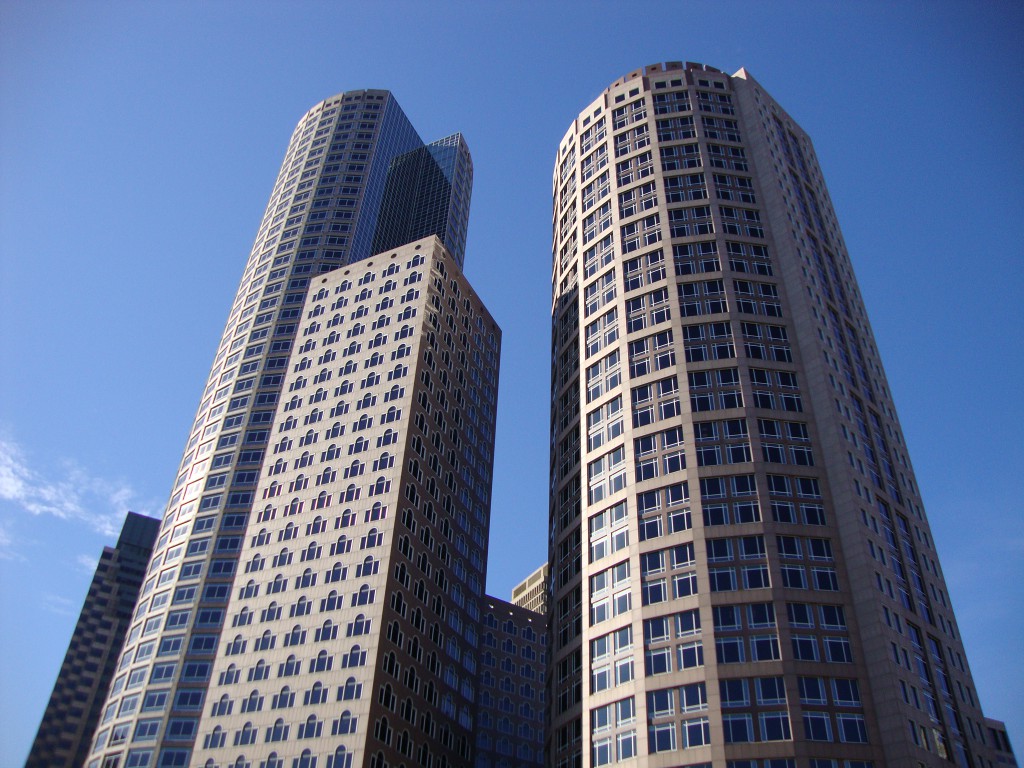
The skyline of the Financial District is really beautiful especially when you view all the skyscrapers from Boston Harbor. One International Place which is adjacent to Two International Place (also the address) are two round Post-Modern towers which really stand out in the skyline. The former was built in 1987, is the fifth tallest building in Boston, is 183 metres (600 ft) tall and has a floor count of 46. The former is the ninth tallest in town, is 164 metres (538 ft) tall, has 36 storeys and was completed in 1992. If you cross the Seaport Boulevard Bridge to the Fort Point neighbourhood you will have a great view of the towers and the skyline. There is also a nice little Harborwalk between this bridge and the Congress Street Bridge. From here you will also have a great view of the InterContinental Boston Condos at 500 Atlantic Ave. This is a really beautiful modern curvy glass structure which is definitely worth checking out. It was designed by Howard Elkus and holds 424 hotel rooms and 130 units.

Exchange Place at 53 State Street in the Financial District is a pretty cool modern glass tower. It was built in 1985, is the 12th tallest building in town, is 155 metres (510 ft) tall and has a floor count of 40. The Old Custom Clock Tower is also worth checking out at 3 McKinley Square. It was completed in 1910 and is 151 metres (496 ft) tall.
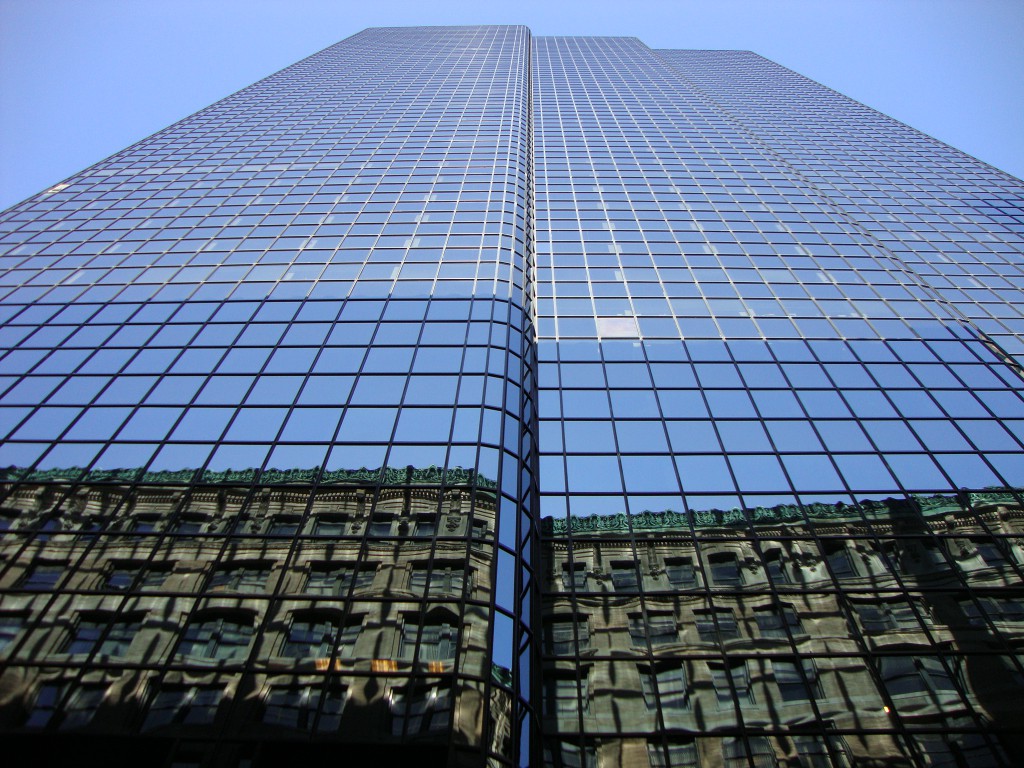
A building that really stands out is the skyscraper at 100 Federal Street which is also nicknamed the Pregnant Building due to the big bulge of several storeys near the base of the building. The architectural style is Art Moderne, it’s 180 metres (591 ft) tall, has a floor count of 37 and was completed in 1971.
Visiting the Massachusetts State House is highly recommended. It’s located at 24 Beacon Street and the building itself is a striking piece of federal architecture, designed by Charles Bulfinch and was completed in 1798. An option is to enter the building at the General Hooker entrance where you have to pass through security first. The statue of General Hooker outside the building is also worth checking out. The Massachusetts State House holds the Senate & House of Representatives of the Commonwealth. Doing the guided tour is great fun and very interesting where you will also get a chance to view both chambers. Mind you, this may depend on their schedule. You will be told about the history of the State House, the early history of the Commonwealth and the creation of the United States.
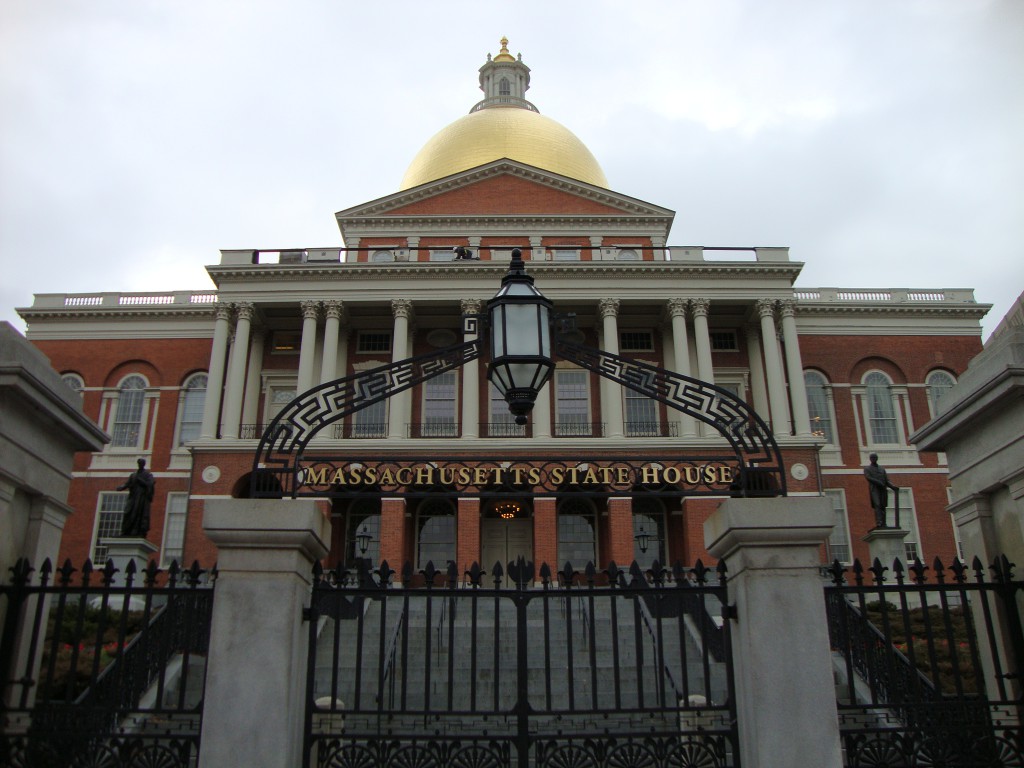
The Massachusetts State House is also a part of the Beacon Hill Historic District and having a walk around here, especially down Beacon Street, is such a delight due to the beautiful architecture. It’s a neighbourhood of a lot of federal style row houses, which evolved from Georgian architecture. It’s one of the most in demand and expensive neighbourhoods of Boston. You will find many interesting historic buildings here. The term “Beacon Hill” is often used in local news as a figure of speech for the state government due to the State House being placed there.
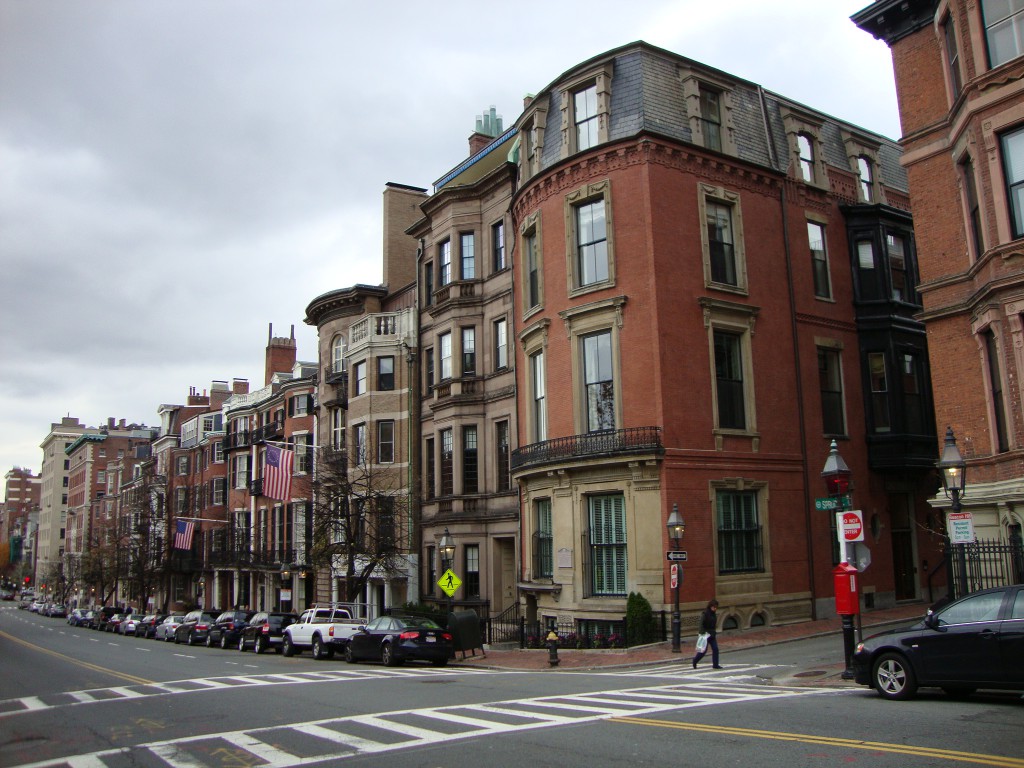
At 84 Beacon Hill you will also find another “Cheers” which is a bar and restaurant based on the concept from the television sitcom “Cheers”. It’s definitely worth checking out as the series is such a classic and it is actually a major tourist site of Boston. The only part of the bar used in the show is the outside entrance. The indoor scenes were filmed in a studio. The bar and restaurant looks nothing like what you see in the show. Mind you, the food is disappointing and nothing special but it’s still an experience to dine at the place due to the concept. There is also a souvenir shop so if you want a Cheers t-shirt or some accessories, this is the place. The Boston Public Garden and the Boston Common is located in the neighbourhood too between Beacon, Boyleston, Arlington, Tremont and Park Streets. Both areas a really nice and definitely worth checking out. There are lots of squirrels here which is cool.
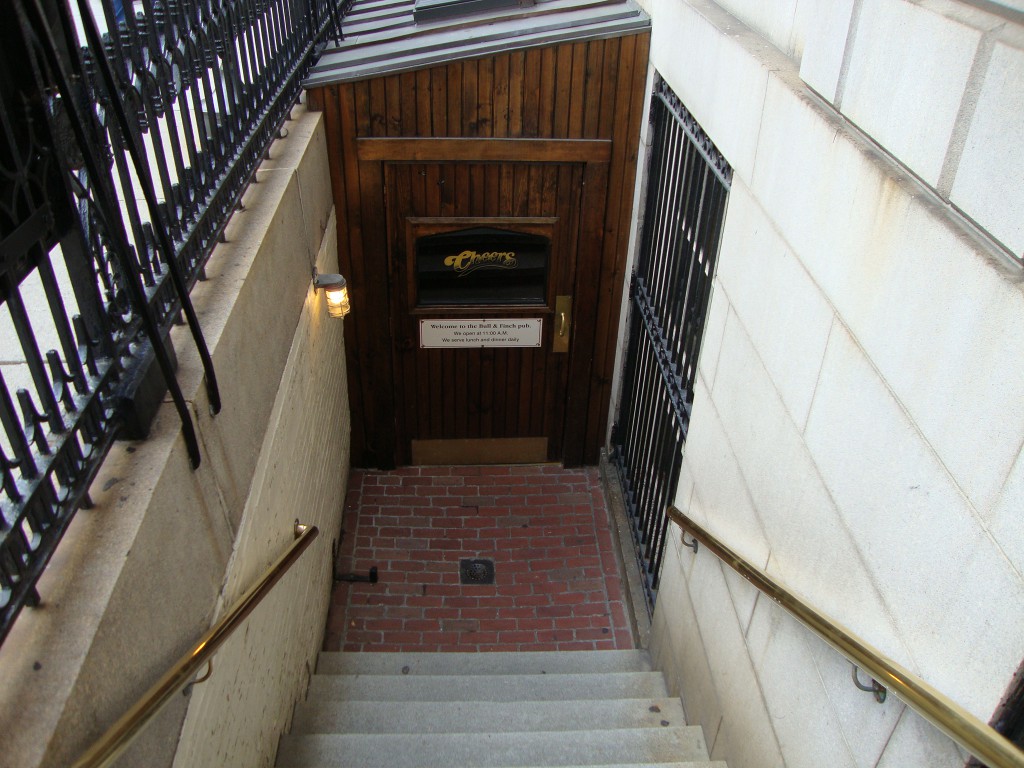
If you are into beer you have to check out the Samuel Adams Brewery which is the biggest craft brewery in the United States and one of the best as well. They have some amazing beers within all categories such as the Boston Lager, the Boston Ale, the Latitude 48 IPA and the more recent addition the Rebel IPA. The brewery is located a bit outside the city centre at 30 Germania Street but you can catch the train to Stony Brook Station and walk from there. When you get to the brewery it’s highly recommended to do a tour. Getting to know the history of the brewery, the founders, their entrepreneurial spirit and the brewing process is really exciting. The staff are really friendly and they are certainly not tight with offering tasters which is included in the price of the tour. You will get to keep your taster glass which is a cool souvenir. They also produced the strongest commercial beer in the world called Utopias at an alcohol % of 24 which will also be shown on the tour. They have a neat little souvenir shop where you can get glassware, t-shirts and accessories. The architecture in this area is actually also pretty neat.
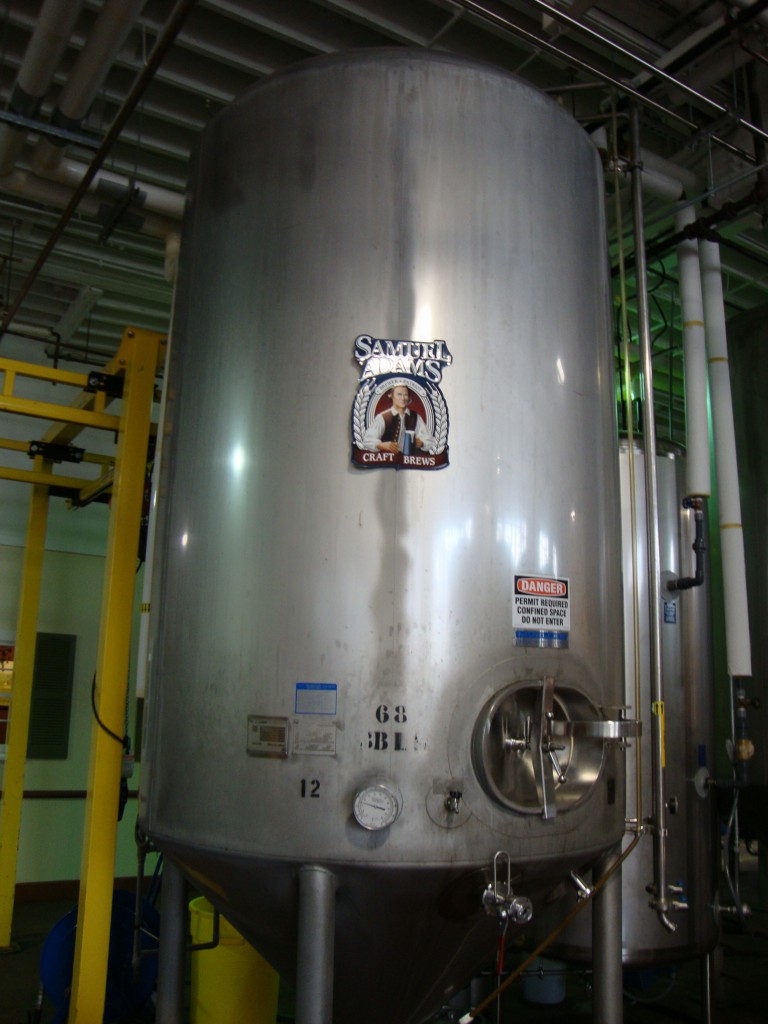
The brewery is actually called the Boston Beer Company but the brand is called Samuel Adams which was named after one of the founding fathers of the United States mentioned earlier. He was said to be a brewmaster himself back in the day but evidence seems to suggest that he wasn’t but a maltster instead. His father made him a partner in the family’s malthouse and there were maltsters several generations back in the family history who produced the necessary malt for the brewing of beer.
Going to Cambridge to have a look at Harvard University is an absolute must while you are in Boston. Having a stroll around the area where Harvard University is based is really cool as you will see some great architecture and some nice shops. Harvard is a privately owned Ivy League research university which was established in 1636 and is one of the most prestigious and influential universities in the world due to its history. The Ivy League is a group of eight private universities in the North Eastern part of the United States which are known for their ivy-bricked buildings. It’s an athletic conference composed of different colleges comprising sports teams from the eight institutions.

There are several ways of doing Harvard itself. You can either just walk around the campus by yourself which is really nice. Mind you, it is pretty big. The students of Harvard do tours which are highly recommended. It’s for free and great fun. Obviously it depends on your guide but they tend to have a very humorous approach to the tour. They are true to the institution but are also pretty sarcastic about certain elements such as the history behind some buildings and statues. It’s all done in a funny and tasteful manner. It is called the “Hahvahd Tour” making a crack at the Boston accent. The tour is free of charge but gratuities are appreciated.
The John Harvard statue located on the campus was made in his honour. There is nothing to suggest what he actually looked like so they used a Harvard student called Sherman Hoar as the inspiration for the face of John Harvard. Tourists tend to rub the left shoe for luck in mistaken belief that students do this as well.
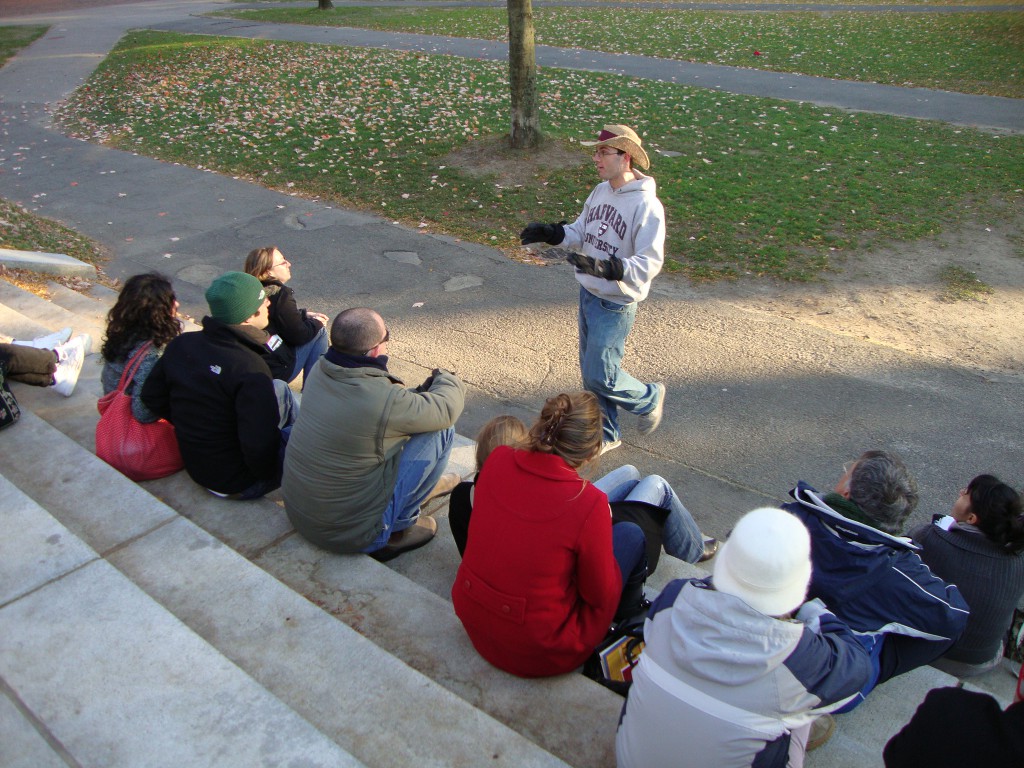
An interesting aspect about Boston is also the distinct accent. It is very cool and one of the most brilliant of the United States. It can make you sound a bit tough in an awesome way. Just to give you a basic idea of how they speak, not regional dialects like North Shore or Southie, just the Boston accent. Bostonians tend to leave out the R’s in certain words so for instance “car” is pronounced “cah” and “park” would be “pahk”. So a sentence that is used to illustrate the absence of the R accent is: “I parked my car in Harvard Yard” which would be pronounced the following way with the Boston accent: “I pahked my cah in Hahvahd Yahd”. Mind you Harvard is in Cambridge which is a suburb mentioned earlier. This aspect is important to the Bostonians. Then again nobody actually ever uses this sentence in day to day life.
There are different O-sounds. There’s the short O which has an “Aw” sound, such as “Boston” becomes “Bawston” and not really “Bahstun”, as it says on a lot the t-shirts and accessories in the tourist shops. A lot of people think Bostonians say “Baaahst’n” but that is not the case, they may be confusing this with the “Ah” sound from “Hahvahd”. Words like “hot” and “stop” are pronounced “hawt” and “stawp”. When the O’s are followed by R’s you get funny sound which turns into more of an “Ar” sound. Like the way they say “shorts”, such as the sentence “it’s hot outside, I’ll wear my shorts” would be “it’s hawt outside, I’ll wear my sharts”. Also the R endings of certain words reduce and go up in pitch, such as “before” is pronounced “befoah” and “forty” becomes “foahty” and don’t have the R-sound of the standard American accent. The R’s tend to disappear, “fork” becomes “fohk”, “shore” is pronounced “shoah” and “there” is “theyah”. In some cases the O’s turn into an “Oah” sound like “job” becomes “Joahb”.
Another aspect is that the short “I” darkens. It’s a very subtle, but an example is “thinking” where you have clear I’s in the standard American accent. With the Boston accent it’s pronounced “th’nken” so it darkens the I’s.
The R’s they lose in the examples before tend to turn up in words ending in A. Like “Amanda” or “Honda”, so that would be “Nice going Amandar” or “I just bought a new Hondar”.
They also have slang expressions like “wicked” which can be both negative and positive. The former would be “it’s wicked hot outside” or the latter which is “she’s wicked good looking”. If food is really good you wouldn’t say “this is some wicked food” but would say “this is some wicked good food”. They also have a bizarre used of the world “bullshit”, pardon the foul language. Normally this is a noun meaning “nonsense”. In Boston is an adjective often used to refer to themselves and it means to be “really angry”. So an example could be, instead of saying “she parked my car, got a ticket and I was angry”, they would say “she parked my car, got a ticket and I was bullshit” or rather with the accent “she pahked my cah, gawt a ticket and I was bullshit”.
Another weird thing is that instead of saying “do”, “is” or “are” they in some cases tend to say “don’t”, “isn’t” or “aren’t”. So instead of saying “I stay out late, but so do you” becomes “I stay out late, but so don’t you” or “Yes, I overslept but so did you” would be “Yes, I overslept but so didn’t you”.
